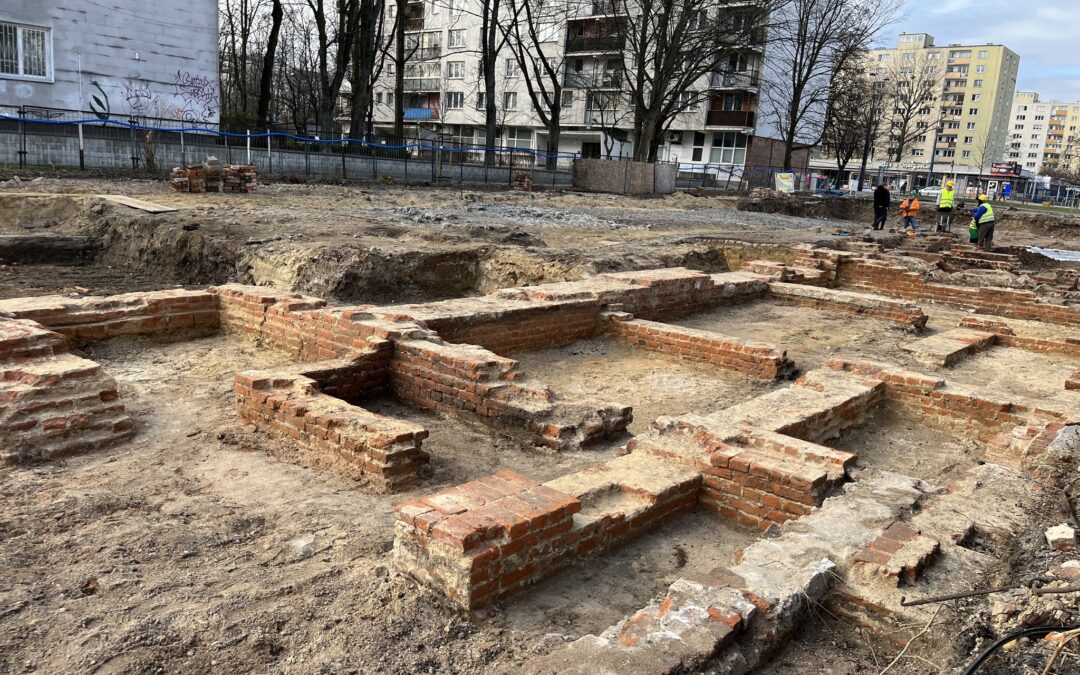Archaeologists have discovered the foundations and basement of a tenement house that was part of the Warsaw Ghetto during World War Two, as well as a number of artefacts from the building.
Fragments of the ground floor, basement, and the paving of a courtyard belonging to a large tenement house were discovered last week on what is now Mordechai Anielewicz Street – named after one of the leaders of the Warsaw Ghetto Uprising.
The uncovered building has been identified as number 33 Gęsia Street, a street that no longer exists. It is thought to have been built at the turn of the 19th and 20th centuries
“It is likely that the tenement house was effectively demolished by the Germans after the fall of the Warsaw Ghetto Uprising, just like the neighbouring buildings standing on the former Gęsia Street,” Michał Grabowski, head of archaeological works at the site, told news service TVN Warszawa.
Number 33 Gęsia Street was for some time the home of the School of Nursing at the Old Jewish Hospital in Warsaw, which moved to the address from Mariańska Street after the beginning of the Nazi’s systematic deportation of Jewish people from the ghetto to death camps in the summer of 1942.
New photographs from the Warsaw Ghetto Uprising have been released after being discovered in an attic by the family of a Polish firefighter who smuggled a camera into the ghetto to secretly take them https://t.co/jtkUUMvmBl
— Notes from Poland 🇵🇱 (@notesfrompoland) January 19, 2023
Before the war, Gęsia Street was densely populated and housed many tenement buildings, but during the Nazi German occupation it was fully incorporated into the Warsaw Ghetto in November 1940. During this time the street housed the ghetto’s central jail known as Gęsiówka.
In 1943 the jail was turned into a concentration camp, which the following year was liberated during the Warsaw Uprising (a separate event from the Ghetto Uprising), with many of its freed Jewish prisoners then joining the ranks of the Polish insurgents.
In January 1945 Gęsiówka began to be used by the communist secret police to imprison Polish opponents of the country’s new Stalinist regime. The facility was eventually demolished in the 1960s.
Unlike the former prison, the majority of the buildings on Gęsia Street did not survive the end of the war. In 1955, the street was renamed after Mordechai Anielewicz, the leader of the Jewish Fighting Organization, a resistance movement.
Police in Warsaw are investigating the disappearance of a historic gate from a building that constituted part of the walls of the ghetto created for the city’s Jews by the German-Nazi occupiers during WWII https://t.co/J1aCYC7fqb
— Notes from Poland 🇵🇱 (@notesfrompoland) January 30, 2023
Grabowski told TVN that excavations are currently being carried out in an area of around two thousand square metres in preparation for the development of a new building at the site. As it will include an underground garage, the area must first be examined by archaeologists.
“We also discovered individual items related to the use of this tenement house, like remnants of kitchen equipment, table sets, as well as several coins. The oldest one comes from the tsarist times, from the end of the 19th century,” said Grabowski.
Grabowski also told the Polish Press Agency (PAP) that lamps, cutlery, an ashtray, and medicine and perfume bottles had also been uncovered at the site.
“I think that for Varsovians and people interested in the history of Warsaw, such objects related to the life of people in those times are very interesting. Each of these objects is a different human story,” he told PAP.
A monument is to be created in Warsaw commemorating the Ringelblum Archive – a collection of documents chronicling life in the city's Jewish ghetto under German Nazi occupation.
It was buried underground during the Holocaust then retrieved after the war https://t.co/uPuzrayI9m
— Notes from Poland 🇵🇱 (@notesfrompoland) January 15, 2021
According to Grabowski, archaeological work in the area will continue for another two to three months but the exact fate of the discovered foundations is unclear at the moment.
When asked by TVN whether the state conservator can oblige the developer to preserve and expose the unearthed foundations, Andrzej Mizera, spokesman for the Provincial Office for the Protection of Monuments in Warsaw, said this could happen “as long as they are of sufficient value.”
The Warsaw Ghetto was the largest of the Nazi ghettos during World War II and the Holocaust. The German liquidation of the ghetto prompted Jewish underground fighters to launch an uprising that became the largest single act of Jewish resistance during the war.
A mural of women who fought in the Warsaw Ghetto Uprising has been unveiled in the city.
Today's anniversary events were dedicated to the "essential but forgotten" role played by women in what was the largest act of Jewish resistance during the Holocaust https://t.co/vdSOTX8RKb
— Notes from Poland 🇵🇱 (@notesfrompoland) April 19, 2021
Main image credit: Warsaw Ghetto Museum / Facebook

Anna Hackett is an assistant editor at Notes from Poland. She is a recent graduate of European Studies from Trinity College Dublin and has had previous journalistic experience with the Irish Independent News & Media group.




















